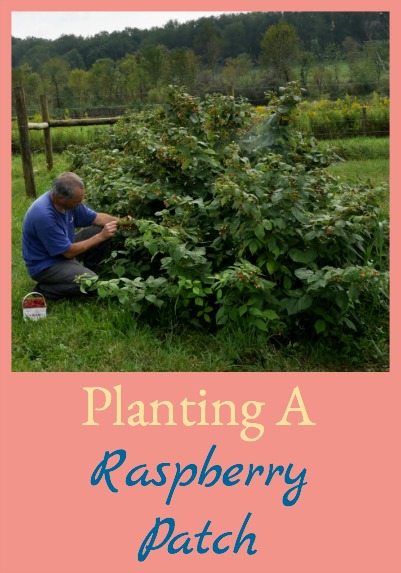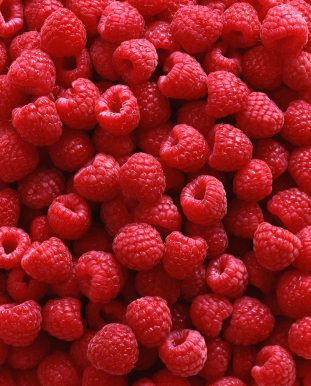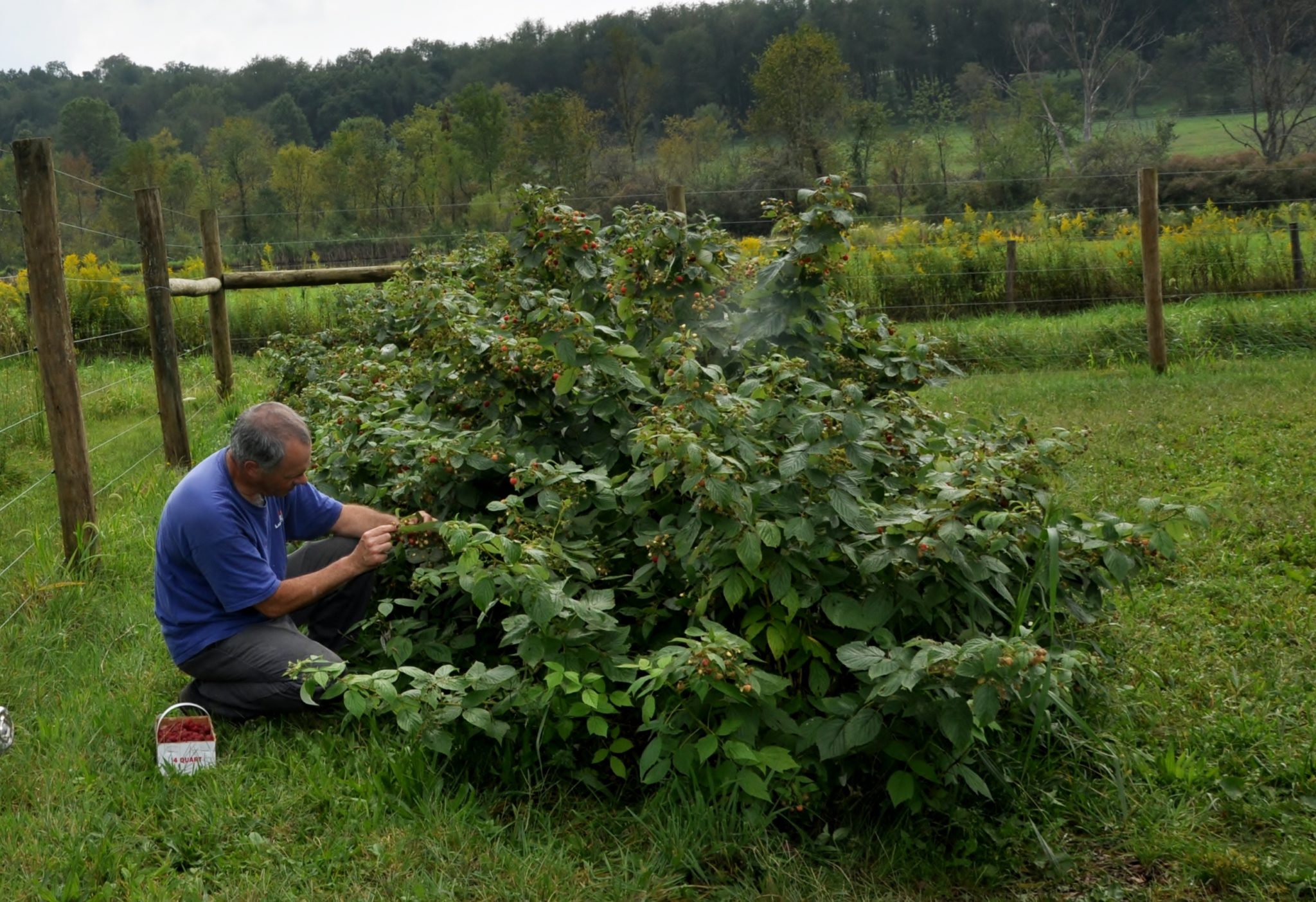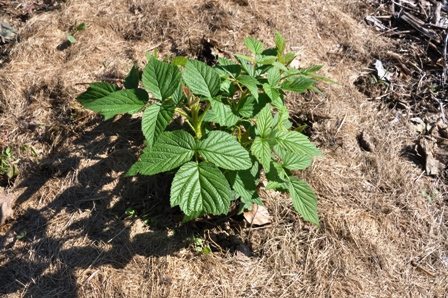Raspberries are perennials and are prolific, so they make great additions to homesteads – 
Because they’re perennials, it’s very important to select the right kind of plant, site, and planting arrangement for your situation. With careful attention to these details, a successful raspberry patch will produce for many years.
Raspberry Cultivars
Raspberries are classified by fruiting type and by color, so the first thing to determine is what fruiting type is preferred. Summer-bearing raspberries fruit once heavily in early summer, and then it’s over; whereas everbearing (sometimes called fall-bearing) raspberries start later but produce over the entire season. We decided to go with the everbearing type – we wanted to pick the little gems over a longer period.
Then there’s the question of color, they may be red, black, purple, or yellow-fruited. Red raspberries ripen earlier, are cold-hardier, have larger berries, and have more erect canes than black raspberries. Purple raspberries are a hybrid of red and black but tend to be similar to black raspberries. Yellow raspberries are the last to ripen but are similar to red raspberries in growth habit. Everbearing raspberries are usually either red or yellow-fruited.
The various raspberry cultivars grow from Zones 3 – 10, so you need to select a cultivar that is appropriate for your zone. Once you’ve narrowed your search to a few cultivars that match your fruiting type, color, and zone requirements, it’s a good idea to visit some berry farms and taste test. Whatever you buy, be sure they’re certified disease free. In our case, we selected three everbearing raspberry types, Heritage (red), Caroline (red), and Anne (yellow).

Taste Test Before Planting
How Many To Plant
Raspberries plants are perennial, but each cane lives two years. Each spring, the plants produce canes which (for summer-bearing varieties) overwinter and produce fruit in the summer of the second year, while new canes emerge to produce the crop for next year. Everbearing raspberries produce a crop on the tips of the first-year canes in the fall, followed by a summer crop lower on the canes in the second year. Second-year canes die soon after fruiting.
Raspberry cane production is prolific, so where there was one cane last year, there’ll be a dozen next year. They also spread by underground runner, so new canes will pop up all around the original planting. Keeping the canes pruned and under control is a chore, so consider carefully how many to start with and how far you want to separate them from other parts of your garden. We started with 4 plants of each
We started with 4 plants of each type and relegated them to the end of the garden. As you can see in the photo below, they can take lots of room once they get established. Be sure to site them where their tendency to spread and space requirements won’t become a problem.

Bramblestone Farm’s Raspberry Patch
Planting Your Raspberry Patch
The best time to plant raspberries is early spring (after danger of severe frost is past), and this is also when you can find the largest selection, although raspberries can be planted anytime during the summer. Raspberries should be planted in full sun (at least six to eight hours per day) and sandy loam that’s rich in organic matter. Raspberries need well-drained soil so avoid low areas, and establish raised beds if necessary.
They should not be planted where tomatoes, potatoes, eggplant, or peppers have been grown because these crops can carry verticillium wilt, to which raspberries are susceptible. Also, raspberries prefer a soil pH of around 6.0 so the planting site should be amended to suit their preferences.

Anne raspberry plant in garden
Raspberries are typically grown in a hedgerow, spaced about 2 feet apart in rows that are 8 feet apart. Bare-root plants should be soaked in water before planting, and set at the same depth as they were in the nursery. If unpruned canes are used, cut them back to 4”- 6” above ground. Adding mulch at planting time is recommended to reduce weeds, retain soil moisture, and add organic matter. Wood chips, pine needles, leaf mulch, or grass clippings maintained at 3 to 4 inches will usually stifle any weeds. We set ours about 4 feet apart in a row 30 feet long at one end of the garden and mulched heavily with grass clippings.
Ongoing Care
Insect and disease management, trellising, pruning, fertilization, and harvesting are all items that need consideration as part of raspberries ongoing care, but getting them in is the first step to harvesting these wonderful berries from your own patch year after year!
Roger says
How and when do I prune the rasberry?
also can I dig up and plant strawberries that grew at other location.
If its ok, when should this be done?
Bobbie Henderson says
Lesa,
GREAT POST and very timely for us. Next season we want to add berries to our farm. Can you recommend a book (print) that we can purchase and study before next season arrives? We want to add raspberries, Marion berries (or thorn-less blackberries) and strawberries. Will most likely look for thorn-less blackberries. We have no knowledge when it comes to planting any berries, or how to trim them, etc., except for strawberries. Any help you can provide would be greatly appreciated.
Bobbie
Lesa says
Hi Bobbie, A book that I liked specific to Brambles was Bulletin 782, from Ohio State University called “Brambles, Production Management and Marketing”. It’s really a book rather than a bulletin and has very detailed information. It is rather specific to Ohio though, and I don’t know where you’re located. Another one that I have and reference is “Fruits and Berries for the Home Garden” by Lewis Hill. It doesn’t have as detailed information on the brambles (raspberries, blackberries, etc.) that the Ohio State book has.